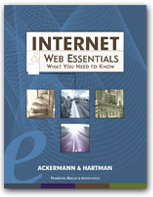The World Wide Web gives us access to a great variety of information on many
different topics. When we want to use the information or resources we find
on the Web for information or research purposes, we need to exercise some
care to make sure they are authentic, reliable, and authoritative. We need
to be equally cautious when we use information from other sources.
Print sources that are available to us through a research or academic
library have often been put through a screening process by professional librarians.
There are several virtual libraries on the Web, and it’s useful to consult
some of these when doing research. Information in such libraries is selected
and evaluated before it’s listed.
It pays to be skeptical or critical of the information we want to use.
It’s relatively easy to publish information on the Web, and information
can be presented in such a way as to hide its intent or purpose. Generally,
as we evaluate documents, we also learn more about the topic we’re considering.
The general guidelines to follow when evaluating resources are:
Citing references or writing a bibliography is usually part of creating
a research report. You provide citations so others may check or examine the
resources used in the report. There are several agreed-upon styles for citing
documents in print format. When using resources from the Web or the Internet,
it is necessary to have a uniform citation format. This chapter presents a
set of formats for documenting or citing information obtained from the Web
or the Internet.
Citations to documents and other information found on the Web or Internet
always include the URL, or Uniform Resource Locator. A URL includes the names
of the Web server and the file or directory holding the information. The URL
therefore tells you which Internet protocol to use to retrieve the information
and where it’s located. You need to be precise in terms of spelling and
capitalization when writing a URL, as a computer will be interpreting it.
We listed URL formats for common Web or Internet services.
There is no uniform agreement on how to cite information from the Web
or Internet. Most styles suggest that a citation include the author’s
name, the work’s title, the date the information was last revised, the
date the information was accessed, and the URL. The date of access is included
because it’s relatively easy to modify information on the Web and the
information may not always be the same as when it was accessed for research.
We discussed methods for determining the date of access and the title of a
Web document. Using bookmarks in Netscape Navigator is an excellent way to
organize resources you’ve found on the Internet. They can be used to
help manage citations.
Summary | Exercises
| FYIs

